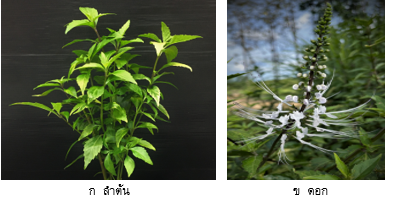การหาสภาวะที่เหมาะสมในการสกัดสารพฤกษเคมี และฤทธิ์ต้านอนุมูลอิสระในหญ้าหนวดแมว
คำสำคัญ:
หญ้าหนวดแมว, พฤกษเคมี, การสกัด, อัลตราโซนิคบทคัดย่อ
การวิจัยครั้งนี้มีวัตถุประสงค์เพื่อศึกษาหาสภาวะที่เหมาะสมในการสกัดสารพฤกษเคมี (ปริมาณฟีนอลิก และฟลาโวนอยด์) และฤทธิ์ต้านอนุมูลอิสระในหญ้าหนวดแมว ในการทดลองแรกได้ทำการศึกษาวิธีการสกัดที่แตกต่างกัน (การแช่หมัก อัลตราโซนิค และไมโครเวฟ) และอัตราส่วนของเอทานอลกับน้ำ (100:0, 80:20, 60:40, 40:60, 20:80 และ 0:100) ต่อนํ้าหนักสารสกัดหยาบ สารประกอบฟีนอลิก และปริมาณสารฟลาโวนอยด์ ผลการทดลองแสดงให้เห็นว่าปัจจัยทั้งสองส่งผลต่อนํ้าหนักสารสกัดหยาบ สารประกอบฟีนอลิก และปริมาณสารฟลาโวนอยด์ โดยสภาวะของสกัดที่เหมาะสมที่สุดคือใช้วิธีการการสกัดด้วยอัลตราโซนิค เวลาสกัด 30 นาที และใช้อัตราส่วนของเอทานอลกับน้ำ (60:40 และ 40:60) ช่วยทำให้ได้นํ้าหนักสารสกัดหยาบ และสารประกอบฟีนอลิกมากที่สุด นอกจากนี้ใช้เมื่ออัตราส่วนเอธานอลต่อน้ำ 100:0 จะสกัดปริมาณสารฟลาโวนอยด์มากที่สุด
การทดลองที่สองได้ทำการศึกษาผลของปัจจัยเดี่ยวในการสกัดด้วยอัลตราโซนิค โดยมีสามปัจจัยที่ได้ทำการศึกษา ได้แก่ เวลาในการสกัด (5-90 นาที) อัตราส่วนของเอทานอลกับน้ำ (100:0-0:100) และน้ำหนักตัวอย่าง (0.5-5.0 กรัม) จากผลการวิเคราะห์ปัจจัยเดี่ยวทั้งหมดที่ได้ทำการศึกษามีผลต่อการสกัดอย่างมีนัยสำคัญ (p<0.05) ต่อปริมาณฟีนอลิก ฟลาโวนอยด์ และฤทธิ์ต้านอนุมูลอิสระของสารสกัดหญ้าหนวดแมว สภาวะที่เหมาะสมในการสกัดด้วยอัลตราโซนิคคือ: ใช้เวลาในการสกัดเท่ากับ 70 นาที อัตราส่วนเอทานอลต่อน้ำเท่ากับ 80:20 และใช้น้ำหนักของตัวอย่างในการสกัดเท่ากับ 5.0 กรัม ด้วยสภาวะการสกัดต่าง ๆ เหล่าทำให้การสกัดสารฟีนอลิก ฟลาโวนอยด์ และฤทธิ์ต้านอนุมูลอิสระด้วย 2, 2-ไดฟีนิล-1-พิคริลไฮดราซิล (DPPH) มีปริมาณมากที่สุดเท่ากับ 951.17 ไมโครกรัมสมมูลกรดแกลลิกต่อมิลลิกรัมสารสกัดหยาบ 2.42 ไมโครกรัมสมมูลเคอร์ซิตินต่อน้ำหนักมิลลิกรัมสารสกัดหยาบ และความสามารถในการยับยั้งที่ระดับการยับยั้งร้อยละ 50 (IC50) ของสารต้านอนุมูลอิสระ เท่ากับ 154.41 ไมโครกรัมต่อมิลลิลิตร ตามลำดับ
เอกสารอ้างอิง
Alshehade SA, Zarzour RHA, Mathai M, Giribabu N, Seyedan A, Kaur G, et al. Orthosiphon aristatus (Blume) Miq alleviates non-alcoholic fatty liver disease via antioxidant activities in C57BL/6 obese mice and palmitic–oleic acid-induced steatosis in HepG2 cells. Pharmaceuticals. 2023;16(109):1-25.
Ashraf K; Sultan S; Adam A. Orthosiphon stamineus Benth. is an outstanding food medicine: Review of phytochemical and pharmacological activities. J. Pharm. Bioallied Sci. 2018;10: 109–18.
Faramayuda F, Mariani TS, Elfahmi, Sukrasno. Plant tissue culture of cat whiskers (Orthosiphon aristatus Blume Miq): A review of secondary metabolite production and micropropagation. Pharmacy Education. 2022; 22(2):92-7.
Nadeem M, Imran M, Gondal TA, Imran A, Shahbaz M, Amir RM, et al. Therapeutic potential of rosmarinic acid: A comprehensive review. Appl. Sci. 2019;9(3139):1-23.
Chua LS, Lua CH, Chew CY, Ismail NIM, Soontorngun N. Phytochemical profile of Orthosiphon aristatus extracts after storage: rosmarinic acid and other caffeic acid derivatives. Phytomedicine. 2018;39(15):49-55.
Masota NE, Vogg G, Heller E, Holzgrabe U. Comparison of extraction efficiency and selectivity between low-temperature pressurized microwave-assisted extraction and prolonged maceration. Arch. Pharm. 2020; 353(10):1-11.
Georgiopoulou I, Louli V, Magoulas, K. Comparative study of conventional, microwave-assisted and supercritical fluid extraction of bioactive compounds from microalgae: The case of Scenedesmus obliquus. Separations. 2023;10(290): 1-23.
Chuyen HV, Nguyen MH, Roach PD, Golding JB, Parks SE. Microwave-assisted extraction and ultrasound-assisted extraction for recovering carotenoids from Gac peel and their effects on antioxidant capacity of the extracts. Food Sci Nutr. 2018;6:189–96.
Siramon P, Wongsheree T, Yuadyong S. Ultrasound-assisted extraction of phenolic compounds from coconut endocarp and its radical scavenging activity. Naresaun Phayao J. 2020;13(3):22-8. (in Thai)
Cui L, Zhang Z, Li H, Li N, Li X, Chen T. Optimization of ultrasound assisted extraction of phenolic compounds and anthocyanins from Perilla leaves using response surface methodology. Food Sci. Technol. 2017;23(4): 535-43.
Correa ML, Dugue BEV, Tobbon JFO. Ultrasound-assisted extraction of phenolic compounds from Adenaria floribunda stem: Economic Assessment. Foods. 2022;11(2904):1-6.
Sai-Ut S, Kingwacharapong P, Mazumder MAR, Rawdkuen S. Optimization of microwave-assisted extraction of phenolic compounds and antioxidants from Careya sphaerica Roxb. flowers using response surface methodology. Appl. Food Res. 2024;4(100379):1-2.
Zhang QW, Lin LQ, Ye WC. Techniques for extraction and isolation of natural products: a comprehensive review. Chin. Med. 2018;13(20):1-26.
Li Y, Tao F, Cui K, Song Y, Nan L, Cui C, et al. Optimization of ultrasonic extraction of anthocyanin in mulberry residue by response surface methodology. IOP Conf. Ser. Earth Environ. Sci. 2020;559 (012024).1-10.
17. Chang CH, Lin HY, Chang CY, Liua, YC. Comparisons on the antioxidant properties of fresh, freeze dried and hot-air-dried tomatoes. J. Food. Eng. 2006;77:478-85.
Ueda Y, Apiphuwasukcharoen N, Tsutsumi S, Matsuda Y, Areekul V, Yasuda, S, Optimization of hot water extraction of dried yacon herbal tea leaves: enhanced antioxidant activities and total phenolic content by response surface methodology. Food Sci. Technol. 2019;25(1):131-9.
Singh JP, Kaur A, Singh, N, Nim, L, Shevkani K, Kaur, H, et al. In vitro antioxidant and antimicrobial properties of jambolan (Syzygium cumini) fruit polyphenols. LWT Food. Sci. Technol. 2016;65:1025–30.
Dent M, Uzelac VD, Penic M, Branic M, Bosiljkov T, Levaj N. The effect of extraction solvents, temperature and time on the composition and mass fraction of polyphenols in Dalmatian Wild Sage (Salvia officinalis L.) extracts. Food. Technol. Biotechnol. 2013;51(1):84-91.
Suedee A. Microwave-assisted extraction of active compounds from medicinal plants. EAU Heritage Journal Science and Technology. 2017; 11(1):1-4. (in Thai)
Jamshaid S, Ahmed D, Aydar AY. Ultrasound-assisted extraction optimization of polyphenols, flavonoids, and antioxidant compounds from fruit of Melia azedarach using a glycerol-based green deep eutectic solvent. J. Food Process. Preserv. 2022;46(8): e16657.
Kumar N, Kumar G, Prabhakar PK, Sahu JK, Naik S. Ultrasound-assisted extraction of bioactive compounds from giloy (Tinospora cordifolia) stem: Quantitative process optimization and bioactives analysis. J. Food Process Eng. 2023;46(6): e14259.
Kkeiman M, Ryu KA, Kahn APE. 2016. Determination of factors influencing the wet etching of polydimethylsiloxane using tetra-n-butyl ammonium fluoride. Macromol. Chem. Phys. 2016;217: 284-91.
Maulana TI, Falah S, Andrianto D.1. Total phenolic content, total flavonoid content, and antioxidant activity of water and ethanol extract from Surian (Toona sinensis) leaves. IOP Conf. Ser. Earth Environ. Sci. 2019;299. 1-9.
Kamkayan P, Assatarakul K. Effect of single-factor by ultrasound-assisted extraction on antioxidant properties of extract from Jiaogulan (Gynostemma pentaphyllum) leaves. JFTSU. 2021;16(2):95-108.
Tabaraki R, Nateghi A. Optimization of ultrasonic-assisted extraction of natural antioxidants from rice bran using response surface methodology. Ultrason. Sonochem. 2011;18(6):1279-86.

ดาวน์โหลด
เผยแพร่แล้ว
รูปแบบการอ้างอิง
ฉบับ
ประเภทบทความ
สัญญาอนุญาต
ลิขสิทธิ์ (c) 2023 มหาวิทยาลัยพะเยา

อนุญาตภายใต้เงื่อนไข Creative Commons Attribution-NonCommercial-NoDerivatives 4.0 International License.
ผู้นิพนธ์ต้องรับผิดชอบข้อความในบทนิพนธ์ของตน มหาวิทยาลัยพะเยา ไม่จำเป็นต้องเห็นด้วยกับบทความที่ตีพิมพ์เสมอไป ผู้สนใจสามารถคัดลอก และนำไปใช้ได้ แต่จะต้องขออนุมัติเจ้าของ และได้รับการอนุมัติเป็นลายลักษณ์อักษรก่อน พร้อมกับมีการอ้างอิงและกล่าวคำขอบคุณให้ถูกต้องด้วย







